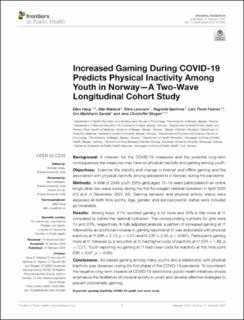| dc.contributor.author | Haug, Ellen Merethe Melingen | |
| dc.contributor.author | Mæland, Silje | |
| dc.contributor.author | Lehmann, Stine | |
| dc.contributor.author | Bjørknes, Ragnhild | |
| dc.contributor.author | Fadnes, Lars T. | |
| dc.contributor.author | Sandal, Gro Mjeldheim | |
| dc.contributor.author | Skogen, Jens Christoffer | |
| dc.date.accessioned | 2023-03-15T12:39:17Z | |
| dc.date.available | 2023-03-15T12:39:17Z | |
| dc.date.created | 2022-01-31T13:58:57Z | |
| dc.date.issued | 2022 | |
| dc.identifier.citation | Haug, E., Mæland, S., Lehmann, S., Bjørknes, R., Fadnes, L. T., Sandal, G. M., & Skogen, J. C. (2022). Increased gaming during Covid-19 predicts physical inactivity among youth in Norway—a two-wave longitudinal cohort study. Frontiers in Public Health, 10, 161. | en_US |
| dc.identifier.issn | 2296-2565 | |
| dc.identifier.uri | https://hdl.handle.net/11250/3058418 | |
| dc.description.abstract | Background: A concern for the COVID-19 measures and the potential long-term consequences the measures may have on physical inactivity and gaming among youth.
Objectives: Examine the stability and change in internet and offline gaming and the association with physical inactivity among adolescents in Norway during the pandemic.
Methods: A total of 2940 youth (58% girls) aged 12–19 years participated in an online longitudinal two-wave survey during the first Norwegian national lockdown in April 2020 (t1) and in December 2020 (t2). Gaming behavior and physical activity status were assessed at both time points. Age, gender, and socioeconomic status were included as covariates.
Results: Among boys, 41% reported gaming a lot more and 35% a little more at t1 compared to before the national lockdown. The corresponding numbers for girls were 14 and 23%, respectively. In fully adjusted analysis, a pattern of increased gaming at t1 followed by an additional increase in gaming reported at t2 was associated with physical inactivity at t1 (OR = 2.10, p < 0.01) and t2 (OR = 2.45, p < 0.001). Participants gaming more at t1 followed by a reduction at t2 had higher odds of inactivity at t1 (OR = 1.88, p < 0.01). Youth reporting no gaming at t1 had lower odds for inactivity at this time point (OR = 0.67, p < 0.05).
Conclusions: Increased gaming among many youths and a relationship with physical inactivity was observed during the first phase of the COVID-19 pandemic. To counteract the negative long-term impacts of COVID-19 restrictions, public health initiatives should emphasize the facilitation of physical activity in youth and develop effective strategies to prevent problematic gaming. | en_US |
| dc.language.iso | eng | en_US |
| dc.publisher | Frontiers Media S.A. | en_US |
| dc.rights | Navngivelse 4.0 Internasjonal | * |
| dc.rights.uri | http://creativecommons.org/licenses/by/4.0/deed.no | * |
| dc.title | Increased gaming during COVID-19 predicts physical inactivity among youth in Norway a two-wave longitudinal cohort study | en_US |
| dc.title.alternative | Increased gaming during COVID-19 predicts physical inactivity among youth in Norway a two-wave longitudinal cohort study | en_US |
| dc.type | Peer reviewed | en_US |
| dc.type | Journal article | en_US |
| dc.description.version | publishedVersion | en_US |
| dc.rights.holder | The authors | en_US |
| dc.subject.nsi | VDP::Samfunnsvitenskap: 200 | en_US |
| dc.subject.nsi | VDP::Medisinske Fag: 700 | en_US |
| dc.source.pagenumber | 1-8 | en_US |
| dc.source.volume | 10 | en_US |
| dc.source.journal | Frontiers In Public Health | en_US |
| dc.identifier.doi | 10.3389/fpubh.2022.812932 | |
| dc.identifier.cristin | 1994857 | |
| cristin.ispublished | true | |
| cristin.fulltext | original | |
| cristin.qualitycode | 1 | |

